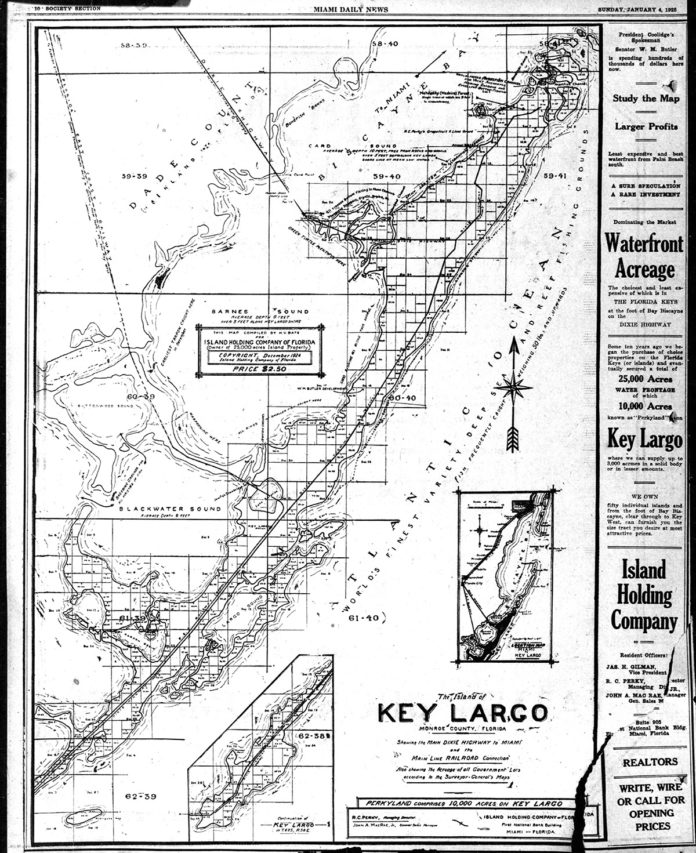Cruising up the Overseas Highway and out of the Florida Keys, there are two ways to drive over Key Largo. Just after Mile Marker 106, the usual option is to follow the highway’s gentle curve, go over the Jewfish Creek Bridge, and up the 18-Mile Stretch. The other option is to keep driving straight and take the slightly longer route.
The slightly longer route is just as scenic. It travels along County Road 905, over Monroe County’s only “rolling hills,” and through an interior more representative of how the islands looked before they were cleared of their natural hammocks. Several miles up the road, County Road 905 is interrupted by a three-way stop. Proceeding through the stop sign and turning left, the route travels up and over the Card Sound Bridge before passing the legendary landmark and home to some of the best conch fritters in the world, Alabama Jacks.
Back at the three-way stop, instead of turning left and exiting Key Largo, it is possible to proceed straight and continue driving north until encountering the security gate at the private Ocean Reef Club. The road heading north and farther into Key Largo was provided compliments of the Island Holding Company, Richter Clyde Perky, managing director. Beginning in 1914, the Island Holding Company started buying up Florida Keys real estate until, by 1924, they had accumulated 25,000 acres that included 50 islands.
On Key Largo, the company owned 10,000 acres of North Key Largo known as Perkyland, and it included Perky’s grapefruit and lime groves. Carved from Perkyland, on Nov. 29, 1924, the Island Holding Company conveyed a strip of land measuring 66 feet wide to Monroe County. The land was used to build a hard-surfaced road that began at what is today the three-way stop where C.R. 905 and Card Sound Road intersect, travels north up through Ocean Reef, and ended just short of Dispatch Creek. On the 1924 map created by the Island Holding Company, the road extension is identified as Dixie Highway.
At Dispatch Creek, a small fishing camp was established. It was sold in 1945 to Seaboard Properties Inc. of Minneapolis, Minnesota, Morris Baker, president. In nearly every history associated with North Key Largo, what Baker purchased, sight unseen, was a 40-acre property containing the Dispatch Creek Fishing Camp – including some I have written.
As it turns out, the same old story repeated over and over again about how Morris Baker purchased the Dispatch Creek Fish Camp and the 40 acres surrounding it, sight unseen, is not entirely accurate.
He did buy it without having first seen the property.
However, contemporary documents do not identify a fish camp called Dispatch Creek or substantiate the 40-acre claim. They reveal that the Tropical Isles Club Inc. sold the original Ocean Reef property to Seaboard Properties Inc. on Sept. 25, 1945. The price was $20,000 and included the acreage and the buildings and inventory of the fishing camp. As for the size of the property identified in the transaction, the legal description had two separate lots, one of 80 acres and one of 33.76 acres for a total of 113.76 acres – a far cry from 40 acres.
Also complicating the generally accepted history of the property is the name of the fishing camp. It was not, apparently, called the Dispatch Creek Fishing Camp. Early 1940s newspaper accounts identify it as the Ocean Reef Fishing Camp. Also, it is listed in the deed of sale as the Ocean Reef Camp.
Among the assets listed were a primary two-story structure with a galley, four-burner bottle gas stove, a downstairs dining room, and an open second floor with two single beds, one double bed, four pillows, a grass rug and an electric floor lamp. Two smaller cabins are also listed, each containing two single beds, a grass rug, and an electric lamp. Additionally, there is a boathouse containing miscellaneous skiffs in “as is” condition and a Nassau sailing dinghy.
According to several contemporary newspaper articles, Rex Pollard operated or managed the Ocean Reef Fishing Camp before its sale to Morris Baker and Seaboard Properties. After the sale, Pollard is reported to have been a charter boat owner who also rented landing barges. In 1948, Rex Pollard was identified as a deputy sheriff in Key Largo with a problem. Two months prior, the wooden Steamboat Creek Bridge had burned down.
When leaving Key Largo and turning left at the three-way stop and rolling down Card Sound Road, Steamboat Creek is the first body of water a car drives over. According to Pollard, since June, when the bridge burned down, “three automobiles have plunged over the steep grade. Some of the occupants have been hospitalized.”
He wanted to erect some kind of barricade to stop the crashes, so he reached out to the State Road Department. They told him to contact the Monroe County Commission, so he reached out to them. They told him to contact the State Road Department. Fortunately, the communication lines operating between local and state government entities are always wide open and crystal clear these days, so that sort of nonsense would never happen.






















